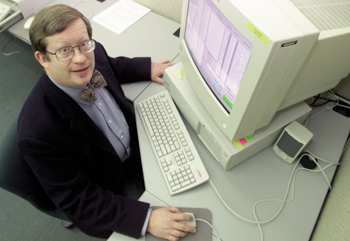
Dr. Randoph A. Miller is professor and chair of the department. He was recruited in 1994 to VUMC to be chair of the division, which was established in 1993. (photo by Dana Johnson)
Informatics boosted to department level
The Division of Biomedical Informatics is officially a department, following review by the Vanderbilt University Medical Center Board and approval by the Executive Committee of the Vanderbilt Board of Trust on Feb. 28. It is one of only four such departments in the country, according to Dr. William W. Stead, associate vice chancellor for Health Affairs and director of the VUMC Informatics Center.
Dr. Randoph A. Miller is professor and chair of the department. He was recruited in 1994 to VUMC to be director of the division, which was established in 1993.
The designation places the program in the academic mainstream at the university. Becoming a department adds weight to federal training grant proposals and allows for the chair to vote as a member of the executive faculty. It will also help the facilitation and promotion of newly established masters and doctoral degree programs in biomedical informatics. Dr. Constantine Aliferis, assistant professor of Biomedical Informatics, will direct the programs.
Miller called the board’s decision “recognition that the performance of the biomedical informatics faculty merits our being a department.” The decision also establishes a landmark in the still-early history of biomedical informatics, he said, by adding its prestigious name to the short list of institutions that have pioneered the field.
The executive faculty had previously voted unanimously to promote the division to department status. “The school has recognized biomedical informatics as an area of knowledge that needs to be taught to medical students, as a resource and as an area in which we are at the top in the country and a world-class leader,” Stead said.
Stead and Miller credit Dr. John E. Chapman, dean of the medical school, with providing the division of biomedical informatics latitude in its execution of research and study that led to rapid and strong growth in the field.
“Dean Chapman had the foresight in 1993 to set us up as a division of the school of medicine, not as a division of another department,” Miller said.
Chapman’s blueprint also allowed the medical center’s infrastructure to be the “applied lab” for biomedical informatics, Stead said. “We had access to tools and techniques that most places don’t have,” he said.
Two biomedical informatics programs, WizOrder and Star Chart, have proved effective and efficient. StarChart, an electronic patient record charting system headed by Dario Giuse, Ph.D., associate professor of Biomedical Informatics, was implemented in less than a year for less than $500,000, compared to similar programs at other institutions that took two to four years to develop at costs of more than $6 million, Stead said.
WizOrder, developed by Stead, Miller and former research assistant professor of Biomedical Informatics Dr. Antoine Geissbuhler, “has allowed us to put information into our physicians’ hands that have reduced the numbers for redundant or unnecessary basic chemical panels by 60 percent,” Stead said. Since 1999, WizOrder and a number of other WizOrder-based interventions initiated by the Resource Utilization Committee and carried out by faculty have dropped $4.5 million to the hospital’s bottom line.
The timing for a department couldn’t be more right for biomedical informatics, which Stead describes as the “intersection between computing and the distribution of information.” Miller points to the 1999 Institute of Medicine’s report on medical errors – at costs of $77 billion annually and 7,000 deaths a year – as one reason to tighten and better control medical information. And, Stead said, managing information is going to become increasingly important to the meteoric growth in the fields of genomics and proteomics.
Medical industries, especially genomics and proteomics, also are fueling the need for new biomedical informatics professionals. The new department now has 13 faculty members. Miller expects three to five students enrolled as masters and doctoral students within the next year, and a steady enrollment of 10 to 15 students in any given year once the program gets underway.













